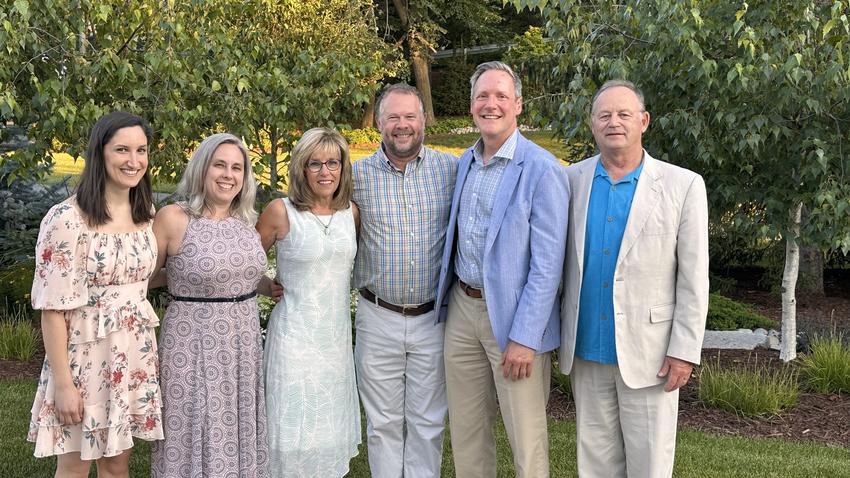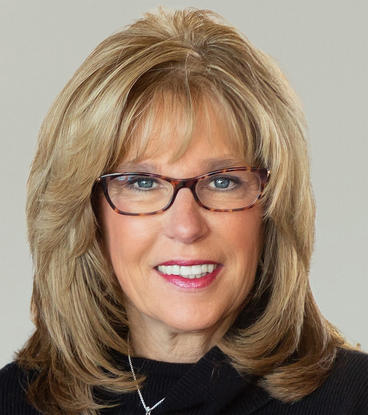Pain management helps bring the light back for orofacial pain patient

Pictured, Derks with members of the orofacial pain team. from left to right: Talia Just, DMD, Emily Kahnert, DPT, CCT, Gloria Derks, Donald Nixdorf, DDS, MS, Alan Law, DDS, PhD, Paul Olin, DDS, MS. Not pictured: James Swift, DDS.
After seven years of pain and questions, relief came for Gloria Derks through the School of Dentistry.

A native of Hastings, Gloria lives between Texas and Hudson, WI with her husband, Ken. Gloria’s friends describe her as a light in their lives—“she loves people and people love her!,” said one friend.
But in 2017, that light felt dim. Gloria developed a ringing sound in her right ear that wouldn’t go away. She sought help from an ear, nose and throat doctor, an internal medicine doctor and a general practitioner, but it seemed that no one could help. “No one could figure out what was wrong with me,” she recalled. “Nothing came up.”
That December, Gloria broke a front tooth, leading to the discovery of an abnormal growth on her condyle. “My jaw was out of all alignment, I had intense pain and the ringing was getting worse,” she recalled. Meetings with oral and maxillofacial surgeons led to the recommendation of a double joint replacement—something that did not feel right or necessary for her. “I didn’t feel that I needed a double jaw joint replacement since my left jaw joint was perfectly healthy,” she said.
On the advice of a plastic surgeon in Minneapolis, Gloria was referred to the School of Dentistry. “I’m not sure who the right doctor is, but they have the best team of oral maxillofacial surgeons to take on your case,” said the doctor. After researching the oral and maxillofacial surgeons at the School of Dentistry, she found James Swift, DDS, professor of oral and maxillofacial surgery. In conjunction with surgery, Gloria was also connected with Donald Nixdorf, DDS, MS, professor and director of the Division of TMD and Orofacial Pain, for pain management throughout the process.
“The end goal of the Division of TMD and Orofacial Pain is always the patients, improving the lives of those suffering with pain,” Nixdorf explained. “The study of pain is continually evolving.” Once thought to be psychosomatic, chronic pain and its management has been long-ignored, according to Nixdorf.
“Generally, universities have buildings to house research of great importance, like a heart institute or a cancer center. Where is the ‘pain’ building?,” he reflected. “As someone who both cares directly for patients suffering in pain and thinks globally about the problem as a researcher, there is a mismatch between the need for improved research, education and patient care, and the resources made available to address this pressing need.”
That need is exactly what Nixdorf tries to address with patients like Gloria. In addition to her surgeries, Gloria attends physical therapy and other pain management care from Nixdorf and his team, and it’s changed her life.
“This has been a long journey, but a positive one thanks to Dr. Nixdorf’s care. I couldn’t have gotten through it without the orofacial team I have,” Gloria reflected. “The quality of care I have received from a medical, emotional and personal standpoint is unlike anywhere else. They understand pain and how debilitating it can be. When you are a patient of Dr. Nixdorf’s, you are not a number in the system. I feel very blessed and fortunate to have them as part of my life.”
Having the best team of both an oral surgeon and orofacial pain care was critically important to her care. The team worked closely with her dentist at the School of Dentistry and her endodontist to help with her ongoing care. That teamwork and care continued as Gloria developed a second benign tumor on her right condyle two years later, requiring another surgery and more additional physical therapy treatments. But no matter the challenge, Nixdorf and his team were there for Gloria every step of the way.
Thanks to this care, Gloria felt compelled to give back to the clinic as a grateful patient, donating funds for research and patient care. “Other patients in similar situations need to have the same opportunity to be connected with orofacial pain specialists,” Gloria said. “Also, it is very important for oral surgeons and dentists to be aware of the connection with orofacial pain specialists as part of their team. Specialties provide for a more positive outcome.”
Gloria believes strongly in the mission of the division. “This clinic understands pain in a way many other clinics don’t, and they provide you with the tools for pain relief and management,” she said. “I want to support their efforts as I feel it’s critical they have the latest technology as patient care needs change and progress. This program needs to flourish as it’s the best as far as I’m concerned.”
Nixdorf is incredibly grateful for the generosity of donors like Gloria, who help the division and the clinic’s continued growth.
“These funds help us meet our ultimate mission: to improve the lives of those suffering with pain,” he said. “Financial contributions speak volumes about what is important to people, and shine a light on those causes. So I’m very grateful to donors like Gloria. With their help, maybe someday there will be a dedicated ‘pain’ building.”
Learn more about the TMD, Orofacial Pain and Dental Sleep Medicine Clinic.